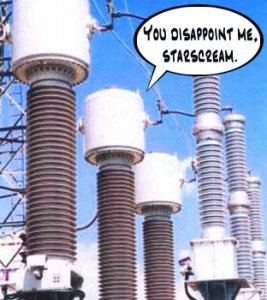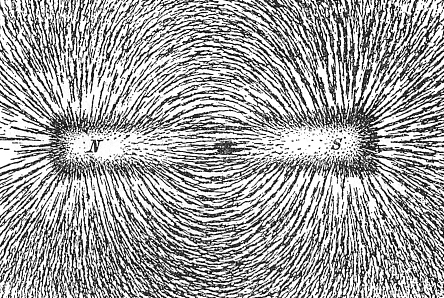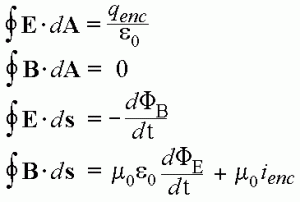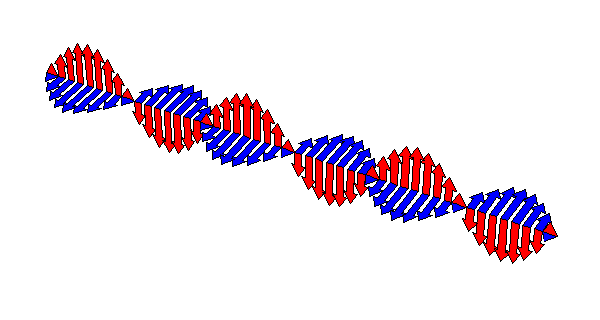Magnetism: Electricity’s Wacky Next-Door Neighbor
Modern physics states that the universe is governed by a set of five basic forces: gravity, the strong and weak nuclear forces, electromagnetism and heart. You’ll note right away that magnetism doesn’t stand on its own right, instead being inextricably tied to the electric force. The discovery that these two seemingly disparate forces are, in reality, just different facets of a single unifying phenomenon was one of the great triumphs of 19th century physics, and in many ways established the foundations of the 20th and 21st century’s electrically-powered society. Let’s take a look at some salient features of magnetic fields and forces:
I. Changes in electric fields generate accompanying magnetic fields
This is an over-simplified statement of Ampere’s Law. Most of us are familiar with this principle from an experiment many did in elementary school: generating a magnetic field using a flowing electric current. Just wrap a copper wire around a pencil a few times, connect its ends to the poles of a battery, and watch in awe as you’ve created an electromagnet! (Bonus: try and do this near the security checkpoint at an international airport. There’s nothing TSA finds funnier than exposed electronic components.) The law is named for its discoverer, André-Marie Ampère, who used these devices to simultaneously solve 18th century France’s Excess-Pencil and Scattered-Paperclip Crises. And all while having a girl’s name. Good hustle.
II. Changes in magnetic fields generate accompanying electric fields
My personal favorite of the classical electrodynamic laws, and it should be yours too if you’re into things like “making electricity from non-electricity.” This is a grossly over-simplified statement of Faraday’s Law of Induction, the principle underlying the function of nearly every classical electric device: from electric turbines to those adorable hand-crank thingies they used to put on the front of cars. More on those later.

Michael Faraday, the true "Master of Magnetism," ca. 1845. Not pictured: other members of the "Brotherhood of Evil Natural Philosophers" (later renamed "The Royal Society of London.")
Note that this law brings a kind of symmetry (though not true symmetry in the mathematical sense) to Ampere’s law: by varying the field due to either electricity or magnetism, you simultaneously generate a field of the other component. In fact, through clever tinkering, one can simultaneously exploit both of these principles as a means of wirelessly transferring power between two circuits. Imagine an electromagnet of the sort described above, with its coil placed in close proximity to separate coil that’s disconnected from any power source. A variable current delivered to the electromagnetic coil will (by Ampere’s law) induce a variable magnetic field. The second coil experiences this changing magnetic field and (due to Faraday’s law) an electric field that ultimately drives a second electric current. Devices of this sort should be well known to you: they’re called transformers.

More than meets the eye, indeed.
III. Magnetic Field lines are curved (or infinite)
…A consequence of Gauss’ Law of Magnetism, (not to be confused any of the bajillion other things named for C. F. Gauss. That guy was a goddamn badass…) which states that the sum of all magnetic field lines entering a closed surface is always equal to the sum of those lines leaving that surface. This is in stark contrast to electric field lines, which all point away from positive charges and toward negative charges, or to gravitational field lines, which point in the direction of massive objects (at least, in simple cases). Both of these other examples can exert straight lines of force, as well, whereas real magnetic fields have curves. Again, many of you might have already seen an illustration of this principle in high school science classes:

A classic scientific experiment for children, illustrating what it would look like if we put a bar magnet on the floor of a Dickensian child sweatshop.
…whereupon you probably thought, “Wow, my previous experiences of iron filings sure made that demonstration so culturally relevant!”
IV. Putting magnetic and electric fields together
The three laws mentioned above, Ampere’s Law, Faraday’s Law of Induction and Gauss’ Law for Magnetism–taken together with another of Gauss’ Laws (dude was a bad. ass.)–constitute a classic set of differential equations that underlies the entire fields of classical electrodynamics and optics. They’re termed Maxwell’s laws, after the Scottish physicist James Clerk Maxwell. This is widely attributed to an arcane pre-E.U. labor regulation requiring that peaceful collaborations between British (Faraday), French (Ampere) and Prussian (Gauss) citizens be overseen by Scotsmen. It’s largely believed that this law is to blame for Europe’s eventual focus on non-peaceful collaborations.

Maxwell's laws. Top to bottom: Gauss' Law, Gauss' Law for magnetism, Faraday's Law of Induction and Ampere's Law. They may look difficult, but simultaneously satisfying all four is easier than satisfying all of the laws laid out in Deuteronomy.
No, these equations bear Maxwell’s name because he was the one who initially proved that they’re sufficient in describing the electric/magnetic fields present in essentially any scenario. Given some input data about a system (the distribution of charges, electric current, &ct) one could, in theory, use these equations to derive a general equation that describes the electric and magnetic fields in the system at any point in space and time. In most cases, this calculation is what we in the science biz call “a colossal brainfuck very challenging,” but a simple, peculiar solution pops up if one considers a system containing no charges or currents. Of course, a trivial solution states that the electric and magnetic fields are each zero. But, Maxwell proved that the Laws could also be satisfied by a traveling wave equation, in which an electric field oscillated parallel to one axis, a magnetic field oscillated along a perpendicular axis, and the whole system moved forward along a third, mutually perpendicular axis. Check out this animation, which I stole from some website somewhere totally made myself. The blue bars indicate the magnetic field lines; red are the electric field lines:

"Bang, bang Maxwell's Light Equations came down on her head! (Do do do doo doo...)"
This phenomenon, a traveling pair of coupled, oscillating magnetic and electric fields is termed electromagnetic radiation, or more commonly, light. Maxwell proved that the speed at which these fields propagate in a vacuum is, in fact, c, the speed of light in a vacuum. Furthermore, he could prove that this speed is the same irrespective of the observer’s reference frame. This last result places c as the absolute speed limit in our universe, and lays the groundwork for Einsteinian relativity.
V. Pretty much everything you care about is magnetic
One last little bit before we return to the comfortable world of Comic Book-Themed Summer Blockbusters. In the world of quantum physics, all particles are defined by a series of fundamental characteristics, many of which defy simple explanation. One of these is the quantum spin, so termed less because scientists actually believe that these tiny particles are spinning about their axes, and more because the math describing them is similar to that describing spinning objects. Depending on its value, a particle’s quantum spin number can imbue the particle with a magnetic dipole moment–i.e., can generate a tiny little magnetic field. This might seem like a bit of a physical curio, were it not for that fact that, many atomic nuclei (a prominent example being hydrogen–the most abundant element in the universe, and ~11% the mass of any given water molecule) and electrons each fall into this category. Which is to say, nearly all of the particles from which you (and all of your surroundings) are made are, in fact, a tiny little magnets. This phenomenon forms the basis for both NMR spectroscopy, and medical MRI, if not a sizable portion of ill-informed beat poetry.
So, now that your knowledge of basic electrodynamics far exceeds that of the average medical student, what can we infer about Magneto’s powers? Or rather, of his lack thereof?

Magneto should be able to suppress electromagnetic fields as well as create them, right? In that case, wouldn’t he be able to instantly separate water into clouds of hydrogen and oxygen? Or even into, like, a giant cloud of free neutrons and neutrinos?
If Magneto’s powers come from control of the Electromagnetic force, rather than the shape of the atoms of magical mutantiness, wouldn’t that imply that he also has control over Weak Nuclear Force by way of Electroweak unification? If he could control the Weak nuclear smoke, he should just be able to dissolve anything in his way into a puff of dust and radiation, like a bank vault door or any pesky X-men in his way, and the ability to dissolve anything or anyone seems quite scary enough. Marvel Universe: where Weinberg was wrong?
These are excellent questions! Makes me glad I wrote this post.
@Jordan: He should be able to nullify magnetic fields, I guess (or rather, create a magnetic field of equal magnitude but opposite polarity, thereby summing the overall field to zero). But I don’t think that’d let him disintegrate molecules. The bonds between atomic nuclei are indeed formed by electrons, which can be thought of as being in a constant state of motion, but beyond that we get into the world of quantum magnetism, which is quite a bit hairier. Because of Heisenberg, we can’t really think of an electron as a little ball in orbit around a bigger ball (as it’s so often schematized). Or rather, we *can* think of it that way, but wouldn’t be able to know how fast it’s going (and hence, the change in its Electric Field vector). In quantum physics we summarize an electron (or any other quantum system) in terms of a Wave Function, Psi(x,y,z,t), which can be thought of as the square of the probability function. That is, SqrRt(Psi(x,y,z,t)) will give you the probability of having an electron in a given position, (x,y,z) and time, t.
Molecular bonding, then, happens when the electrons inhabiting a given atomic Psi function are moved into a new Psi function centered around each of the atomic nuclei in the bond. The energetics (and hence, allowable bond-forming/breaking functions available to a system) are dictated by Highest Occumpied Molecular Orbital/Lowest Unoccupied Molecular Orbital theory—or the so-called “HOMO/LUMO” model. SO, in order for magneto to disintegrate water into its substituents, he’d have to (A) Have a handle on the probabilistic, quantum magnetic fields generated by the current HOMO in H2O (herher..) and then (B) be able to generate a field that’d swap the energetics of them such that the electrons repopulate atomic orbitals (which are normally higher energy than molecular orbitals). It’s a tall order. To wit, I don’t know of any device that can use magnets to make or break atomic bonds.
Photolysis, on the other hand, should be well within his wheelhouse. There are a number of cases where atomic bonds can be made/broken by addition of light. X-rays, for example, are fantastic at breaking all sorts of bonds nonspecifically, but many bonds will respond to a single wavelength of applied light. One can even photolyse water, for example. But the effects of this weapon would be less specific: I imagine that, once he’s generated powerful enough light to lyse water molecules in your body, you’d probably get severely burned by the effects that light’s having on all your non-water molecules, too.
As for your answer to the neutrino separation, check out my answer to Liza’s question…
@Liza. True, but non at this temperature, right? Electroweak unification-the point where the virtual photons that “exert” the electromagnetic force “merge” with the W and Z bosons of the Weak Force-doesn’t spontaneously happen until you get to ~10^15 K. (In Boston, for example, it’s currently ~307 K, so we’d have a ways to go). Statistical thermodynamics informs us that any allowable transition should be attainable at any temperature, but with different probabilities. I don’t know what the partition function (which allots the allowable energetic states into different probabilities) looks like for electroweak unification at these temps, but I’d hazard a guess that it’s <<< 1 in 10^23 (since, for example, we never observe, like, spontaneous explosions of water molecules in 18 mL of water).
SO, Magneto'd be able to exploit the Weak Nuclear Force, but veeeeeerrry little of it. Caveat: he'd hold more sway in the center of the sun.
Do the same people that lobby for intelligent design textbooks also lobby for the LUMO-only model of molecular dynamics?
Terrific article, I’m sharing it with all my comicky friends. All it takes is for one person to come along and write the story, of course, and then all his powers could at last break loose.
This is incredibly good. One of the best articles I’ve read in a long time. Very well written, very entertaining, very clever. I commend you.
This article is why I love over-thin king it.
I only wish I was knowledgeable enough to say something clever.
Aww… thanks so much, Tim, Archie and Stefan! I always worry that my particular fondness for math might scare away, well, everybody. :)
@Jordan: It only gets worse, sadly. Depending on the energetics and local structures of two molecules’ HOMOs and LUMOs, they can sometimes react by what’s termed an “SN2” mechanism, otherwise called “Backside Attack.”
Yes, that’s right. All across the country, Orgo students are required to answer problem set questions of the form, “…do molecule X and Y’s HOMOs support a backside attack model?” with a straight face.
Now that I think of it, I’m gonna’ start marketing T-shirts to bible-belt chemistry students that read, “God Made Adam and Eve, not Pi and Pi*.”
Perhaps he’s really just lying about his abilities, knowing that if the truth were revealed he’d be farmed for his midichlorians.
I think he’s actually just snapping branes around like a repressed locker-room towel whip.
Insane in the P-brane! Insane in the brane!
Or maybe he has a magic garment. I suspect it’s that nice Casimir turtleneck.
I (or you) could argue that this helps to explain his seeming genius level grasp on every field of science from genetics to particle physics to how mutant powers actually -work-.
I think the limits to his powers are more to do with the limits of the human mind. I propose tehre is a limit to the number of electro magnetic fields he can generate at a time. Lets for the sake of argument agree that that number is 1000. I base that on the maximum number of objects I have seen magneto manipulate at a time in the x-man series. Given this it is best if he focuses his magnetic fiels on objects that have all their atoms aligned with their poles in the same direction. Otherwise he would have to create a new field for each atom. An object made up of only 1000 atoms would be quite small. So he instead focuses on metal objects.
I also don’t think he could change his apearance because that would require a magnetic field orchestrated in an extremely complex shape. A different curve for every change would be needed. He could however make himself disapear with a spherical field diverting light around him.
Again I think the limitations are with his mind and the limits of the human mind. We have no specialized portion of the brain for controlling things that are hyper small and large in quantity. We can barely even comprehend numbers over a million,much less the billions and trillions of fields needed to move non magnetic objects.
The arrangement you’re describing in the “telekinesis of nonmagnetic materials” sounds like antiferromagnetism. Most materials are diamagnetic – that is, the molecules tend to align opposite the magnetic field. Put another way, if you graphed magnetization (the net alignment of the molecules) versus applied field for a diamagnet, it would look like a line in the 2nd and 4th quadrants. As such, it’s quite possible to levitate something that’s not generally considered magnetic in a magnetic field – it just takes a pretty large field.
For example, a frog being levitated: http://www.youtube.com/watch?v=A1vyB-O5i6E
For something of that size, the field required is something on the order of 10 tesla (the Earth’s magnetic field is about 50 microtesla; a typical refrigerator magnet is about 5 millitesla). A large field, sure, and one that probably requires a superconducting magnet, but not incomprehensibly large.
@Howard: If I hadn’t seen the levitating frog (strawberry, grasshopper &ct) with own looking-balls, I’d never have believed it. My understanding must be in err, then: I thought that, in the presence of a large external field, the spin vectors (and hence the resultant magnetic dipole) precess. Which is to say, they orient with a vector component–let’s call it z–parallel (or antiparallel) to the field, but with x and y components varying as the vector sum precesses in the circular path. Perhaps this is only applicable in an NMR experiment, amongst the resonant population? Or, perhaps the spin-vector precession doesn’t change the orientation of the external dipole?
True that a 10 T field isn’t huge; it’s roughly comparable to what a mid-level NMR apparatus uses, right? I haven’t done the calculation, but it should be *way* less than what’s required to lift a submarine out of its depths…
@Foxbat – I’ll concede that keeping a hold on thousands of discrete fields would probably be too much for one
person’smutant’s brain to handle simultaneously. However, controlling things that are hyper small (at least in units of time, which is applicable here) is well within the average person’s reach. Anyone who can whistle or sing is consciously vibrating the air around them at hundreds of intervals per second. Doing so doesn’t require an explicit knowledge of the physics of sound, but is essentially instinctive: their brain’s manipulation of the macroscopic outcome (a discrete pitch) is enough–physics can handle the rest. SO, if we assume that Magneto’s control over his powers is as instinctive to him as whistling is to us, then changing the color, direction, polarization of light should be within his scope.@Everybody: Incidentally, it’s unclear to me why magnetic fields can’t lens light on their own, as large gravitation fields do. This is why I described Magneto’s proposed “invisibility” as stemming from his direct manipulation of the individual light beams’ magnetic components–not just by his applying a large field to himself and letting the light bend around him. Anyone care to explicate? Also, how intense (or how dramatic would the cutoff between “in-field” and “out-field”) would a magnetic field need to be in order to generate a Hawking-radiation-type system? That is, if the “quantum foam” yielded two oppositely charged particles *just* at the cusp of an intense field (an ambiguous term I’m using instead of “event horizon”), one should be sucked into the field, while the other radiates away. Of course, unlike Hawking radiation, each of the particles would survive. Thoughts? This is about the point where the emphasis on the *bio* part of my biophysics training becomes painfully clear…
Individual spins do precess, but they precess around any perpendicular magnetic field. The frequency with which they precess depends on the field strength. My understanding of MRI is that it uses nuclear magnetic resonance, which involves first applying a constant field to align the nuclear spins and then hitting the system with an additional pulsed perpendicular field that varies at a given frequency. When the frequency matches the resonance frequency of a given nucleus, there’s some signature that we can measure (this is where my understanding gets fuzzy). According to wiki, a typical MRI in a hospital uses a 1.5-3 T field, with up to 10 being used in research facilities.
Diamagnetism basically works because the applied field perturbs the electrons orbiting the nucleus, changing the flux through the little current loop of the electron orbit, which brings Lenz’s Law into play. It’s a spin-orbit effect (and I kind of hate invoking that), not a spin alignment effect like other types of magnetism. The levitation works by making a field gradient that opposes gravity. It’s not quite the same arrangement as the MRI.
Magnetic fields don’t do anything to light because photons don’t have charge. Same thing with electric fields – there’s no force exerted on anything that doesn’t have a charge, and photons are just traveling waves. The superposition principle applies for electric/magnetic fields, so fields don’t have any effect on other fields. Gravity doesn’t change the photons themselves, as photons don’t have mass. Gravity distorts the space that light travels through. I guess it’s a somewhat subtle point, but there you go. Imagine a ball rolling on a sheet – you can change the ball’s path both by physically touching the ball and pushing it in some direction, or you can do it by distorting the sheet. Gravity does the latter.
I’m not really sure how Hawking radiation works, so I’m not sure I can give a good answer for that question. Magnetic force only changes the direction of a charged particle’s velocity (the force equation involves a cross product), and since the particles are oppositely charged, they would attract and annihilate. So I suppose the answer is that there is no magnetic field you could apply to keep the particles apart. You could do it with an electric field, which would accelerate the particles in opposite directions, but I have no idea how big it would need to be. Presumably it would be huge, since the particle-antiparticle pair would be generated pretty close to one another, and electromagnetism is a relatively strong force.
Has Magneto ever threatened to stop the Earth’s core rotating thereby
giving everyone sunburnSTOPPING GRAVITY AND EVERYONE FLOATING OFF INTO SPACE!?